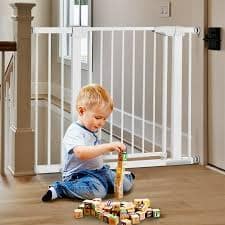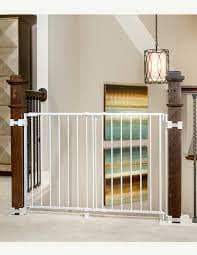Table of Contents
ToggleEnsuring the safety of your little explorer is the topmost priority when they start their thrilling journey of discovery around the house.
One of the most crucial steps in this regard is to install a baby gate on top of the stairs. This seemingly small step is a sturdy guardian, shielding your precious one from possible accidents and stair-related mishaps.
The peace of mind that comes with knowing your child is playing in a secure environment, free from the dangers of staircase falls, is truly unparalleled.
Feel the weight of worry lift as you secure their play area, making your home a haven where laughter echoes and memories are made.
(Short and quick Answer)Install a Baby Gate on Top of the Stairs:
Here are the steps:
- Finally, make sure you teach your child how to safely open and close the
- Measure the width of the top of the stairs for the gate.
- Purchase an appropriate baby gate that fits your stair width.
- Unpack and assemble the gate according to the manufacturer’s instructions.
- Position the gate at the top of the stairs ensuring it’s level.
- Secure the gate using the included hardware; usually screws and brackets.
- Test the gate to ensure it’s securely installed and functions correctly.
- Remember, the gate should swing away from the stairs for safety.
For a detailed or step-by-step guide, Continue Reading the article for more understating and safety purposes.
No matter what type of baby gate you choose, make sure it meets the current ASTM standards for safety—regardless of where or how you use it! While this is one of the most important steps to keep your child safe, be sure to follow all safety recommendations specific to each product. Additionally, review instructions carefully
Step-by-Step Guide: Install a Baby Gate on Top of the Stairs:

Step 1: Choose the Right Baby Gate
When choosing a baby gate, ensure that it is specifically designed for use at the top of the stairs. These gates should be hardware-mounted rather than pressure-mounted, meaning they are attached to the wall or doorway with screws. This provides a more secure installation that won’t be easily pushed down. Look for a gate with a swing door for easy access, and make sure it opens away from the stairs.
Step 2: Measure the Staircase Width
Use a measuring tape to accurately measure the width of the staircase. This is crucial to make sure the baby gate you choose will fit securely. Remember, the gate should not have gaps on the sides that a child could potentially squeeze through.
Step 3: Purchase the Baby Gate
Based on the measurements, select a suitable baby gate. Remember to check the product details and reviews to ensure that the gate meets current ASTM safety standards.
Step 4: Unpack and Read the Instructions
Once you’ve got the gate, carefully unpack all components and read through the installation instructions provided by the manufacturer. Ensure that all parts are included and in good condition.
Step 5: Assemble the Gate
Follow the manufacturer’s instructions to assemble the baby gate. This will usually involve attaching the gate panel to the mounting hardware. Ensure all screws, bolts, and brackets are tightly secured.
Step 6: Position the Gate
Position the gate at the top of the stairs, ensuring its level. Typically, it should be mounted about 3 inches above the floor. Use a level tool to make sure the gate is straight and will swing correctly.
Step 7: Install the Gate
Secure the gate to the wall or doorway using the included hardware. Use an electric drill to install the screws and brackets. Make sure the gate is firmly attached and cannot be pushed or pulled down.
Step 8: Test the Gate
Once installed, test the gate by opening and closing it several times, checking the locking mechanism is functioning correctly. Apply some pressure to the gate to ensure it’s secure and does not move or wobble.
Step 9: Teach Your Child
Finally, it’s crucial to teach your child how to safely open and close the gate. Talk about the importance of safety around stairs and why the gate has been installed. Remember, the gate is not a substitute for adult supervision.
Step 10: Regularly Check the Gate
Regularly inspect the gate to ensure it continues to function correctly and securely. Over time, screws may loosen or the gate may become damaged. If this happens, repair or replace the gate as necessary.
By following these steps, you will ensure that your baby gate is installed correctly and provides maximum safety for your adventurous little one. Remember, the goal is to create a safe and secure environment where your child can explore and play freely.
To get additional expert tips and options for baby gates suitable for tops of stairs with only one wall, don’t hesitate to explore this comprehensive guide.
Why Install a baby gate on top of the stairs?

The installation of a baby gate at the top of stairs is a task not to be taken lightly.
This act not only safeguards your little one from the dangers of tumbling down the stairs but also adds an extra layer of security to your home.
The importance of this safety measure cannot be overstated, especially in houses where the stairs are a central element.
Indeed, stairs can be a fascinating attraction for those tiny, curious minds, beckoning them with the allure of a new adventure. Yet, they also pose a serious risk.
By installing a baby gate, you are not just putting up a physical barrier to protect them from falling; you are also setting emotional boundaries, teaching them about safe spaces and areas that are off-limits.
Remember, the sounds of their giggles and innocent pranks should fill your home, not the cries of fear or pain from a preventable accident. So, make the smart, loving choice.
Install a baby gate on top of the stairs; let your child explore, learn, and grow in a safer environment. Let them be little, wild, and free, but above all, let them be safe.
To dive deeper into the world of child safety and to learn more about why baby gates are the best solution for stairs, check out this comprehensive guide.
Benefits of Install a Baby Gate on Top of the Stairs:

- Prevents Accidents: The foremost benefit of installing a baby gate is the prevention of accidents. Babies are naturally curious and adventurous, and stairs can pose a significant danger. A baby gate acts as a protective barrier preventing your little ones from accidentally tumbling down the stairs.
- Peace of Mind for Parents: With a baby gate installed, parents can breathe a sigh of relief knowing their child is safe. It grants you the freedom to carry out household chores or work tasks without constantly worrying about your baby’s safety around the staircase.
- Controlled Access: A baby gate not only keeps your child away from the stairs but can also restrict access to other potentially dangerous areas of the house, such as kitchens or workshops. This controlled access is crucial for maintaining a secure environment for your child to explore.
- Teaches Boundaries: Installing a baby gate also helps in setting boundaries for your child. It subtly communicates to them that certain areas are off-limits, aiding them in understanding the concept of safe and unsafe spaces.
- Versatility: Modern baby gates come in various designs and sizes, making it easy to find one that matches the decor of your house while fulfilling its safety purpose. Some gates are portable, making it convenient to move around and install where necessary.
Remember, the installation of a baby gate at the top of the stairs is not merely a task; it’s an investment in your child’s safety and peace of mind.
Install a Baby Gate at the Top of Carpeted Stairs:
Installing a baby gate at the top of carpeted stairs can be a little more challenging due to the soft and uneven surface of the carpet.
However, with the right tools and detailed instructions, it’s possible to secure a gate without causing any damage to the carpet.
It’s essential to follow a comprehensive guide and perhaps consider a baby gate specifically designed for carpeted stairs to ensure a snug and secure fit.
For more information and expert reviews on the best baby gates for carpeted stairs, visit this comprehensive guide.
This resource will help you choose a baby gate that perfectly fits your needs while maintaining the aesthetics of your home.
Different Types of Baby Gates to Consider:
When it comes to selecting the right baby gate for your home, there is no one-size-fits-all solution.
The choice depends on multiple factors, such as the area of installation, the age and mobility of your child, and the design aesthetics of your home. Broadly, baby gates can be categorized into two types: hardware-mounted and pressure-mounted.
Hardware-mounted gates are secured to the walls or doorways using screws and are ideal for protecting high-risk areas such as the top of the stairs. They are sturdy, long-lasting, and cannot be easily dislodged by adventurous toddlers.
Pressure-mounted gates, on the other hand, are held in place by pressure and are easy to install or move around. These are suitable for low-risk areas, like between rooms, but should not be used at the top of stairs as they can be potentially dislodged by forceful pushing or pulling.
Furthermore, there are specialized gates like freestanding gates, travel gates, or extra-wide gates that cater to specific needs and situations. The key is to understand your requirement and choose a gate that offers the highest level of safety and convenience.
For a more in-depth understanding of the different types of baby gates and tips on choosing the best one for your home, you can read this comprehensive guide on Which Type of Baby Gates Are Best.
Easy Tips for Installing a Baby Gate on Top of Stairs:
Installing a baby gate at the top of stairs might seem daunting, but by following the correct steps and precautions, it can be carried out effectively. Here are some tips to help you install a baby gate securely:
- Choose the Right Gate: As discussed earlier, for stairs, hardware-mounted gates are the most secure option. They are sturdy and cannot be easily dislodged by your child.
- Measure the Area: Before purchasing a gate, measure the width of the stairway or doorway where the gate will be installed. This will ensure you get a gate that fits properly and securely.
- Install on a Flat Surface: The gate should always be attached to a flat, firm surface. If attaching to a wall, ensure it’s a stud wall. If attaching to a railing, the railing needs to be sturdy and not rounded.
- Follow the Instructions: Each gate comes with an installation manual. Follow the instructions carefully, ensuring each step is carried out correctly.
- Check the Alignment: The gate should be aligned correctly. It should open and close smoothly without any hitches.
- Double Check the Locking Mechanism: Once installed, double-check the locking mechanism to ensure it’s working correctly.
- Regular Maintenance: Regularly check the gate for loose screws or signs of wear and tear. If necessary, repair or replace parts to keep the gate safe and secure.
For a more detailed guide on installing a baby gate safely, you can visit this site.
Conclusion:
In conclusion, installing a baby gate at the top of the stairs is an essential safety measure that every parent should consider. It provides a secure environment for your child to explore, gives peace of mind to parents, and teaches boundaries to children.
The type of gate you choose depends on your specific needs and the physical layout of your home. But remember, no baby gate can substitute for the watchful eye of a caring parent. Regular maintenance and vigilance are key to ensuring that the gate continues to serve its purpose effectively.
So, prioritize safety, choose the right gate, install it correctly, and create a safe and happy environment for your little explorer.


4 thoughts on “Step-by-Step Guide: Install a Baby Gate on Top of the Stairs”